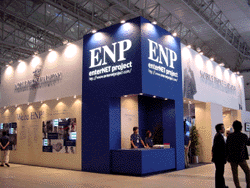ENP: enterNet Project
* This laboratory has been completed.
By using wireless LAN, the adoption of the required authentication technology or architecture is reviewed to enable hybridization and support of broadband mobile phones.
| Number of participating organizations | 13 |
|---|---|
| URL | http://www.enternetproject.com/ |
| Contact |
ENP Office
E-mail:query@enternetproject.com |

Background
Mobile phones as typical mobile communication devices have been contributing to development of information communication including the shift from analog to digital communications. This has been possible due to the vast amounts of capital that were poured into ventures so as ensure public support while aiming to build an environment for broadband communications. With the advent of the 21st century, Type 1 carriers must reduce usage fees due to the increase in data packet services among Internet users and the increase in broadband access as exemplified by the increase in fiber optic cabling. Competition has been increasing among the various telecom companies as the market expands. Let us take mobile communications as an example. No matter how much investment is made, only insufficient bandwidth may be obtained when compared to wired communications since bandwidth capacity is limited. Also, access points for users are not fixed but they ever shifting like nomadic tribes often causing concentrated demand for local communication access. Under these severe conditions, pursuing broader bandwidth and scalability simply by direct capital investment might result in a vicious cycle where vast amounts of investment and a reduction in communication fees must be made at the same time the structure must be broken down. This goes against the users’ interests. To tackle this, a more appropriate solution needs to be found that is possible from the point of improving the communication architecture or from the point of macroeconomics. Above all, industry-university joint organizations are able to negotiate and review from the viewpoints of users, academia and industry and be able to make multilateral proposals.
Objectives
- Promotion of the Internet via mobile phones and improvement of the next-generation infrastructure based on this promotion.
- Implementation of hybrid communication architecture that dramatically improves the mobile communication environment.
- Implementation of a broadband-capable nomadic mobile phone environment via wireless LAN
- Practical application of the information infrastructure and various application services that can be accessed by everyone.
Method (action plan)
- Research on broadband-capable mobile communications architecture that fully utilizes wireless LAN
- Research on security and authentication mechanisms related to the above
- Inspection and comparative study of a range of protocols needed for promoting the Internet with mobile phones
- Evaluation of the applicability of next-generation Internet technologies such as IPv6 and broadband wireless LAN
Expected results
Authentication technology related to access via wireless LAN
(Products or business models are secondary results and therefore excluded from direct results.)
Schedule
The term of the project shall be until Spring 2003.
Demonstration experiments shall start by the end of 2001 and the expected results shall be available by Summer 2002.
Researchers, managers and professors
| Nobuo SaitoDirector | Vicepresident, Board of Trustees, Professor, Faculty of Environmental Information(*) |
|---|---|
| Jun Murai | Executive Director, Keio Research Institute at SFC Professor, Faculty of Environmental Information(*) |
| Junichi Mineo | Senior Researcher, Keio Research Institute at SFC |
(*) Renamed to "Faculty of Environment and Information Studies" in 2007